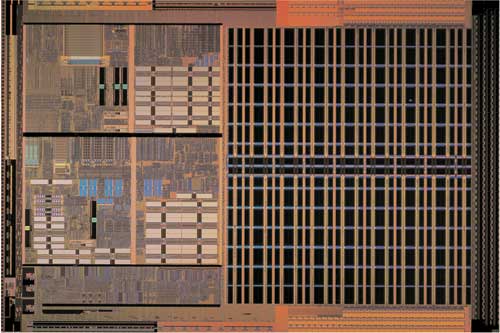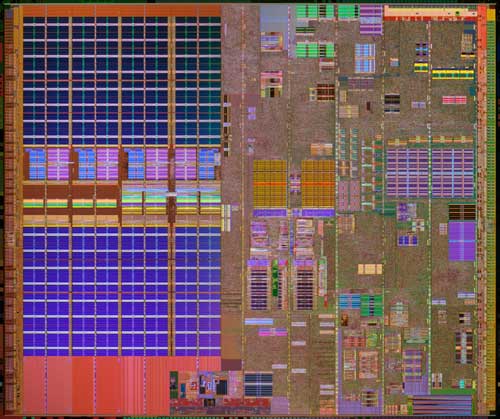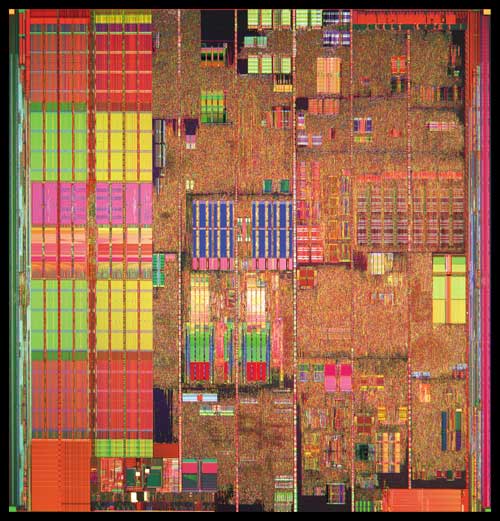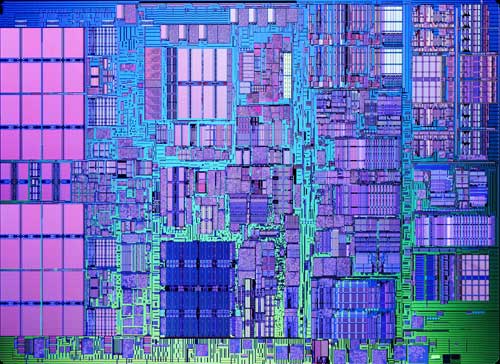Intel Pentium 4 6xx and 3.73EE: Favoring Features Over Performance
by Anand Lal Shimpi & Derek Wilson on February 21, 2005 6:15 AM EST- Posted in
- CPUs
An Interesting Observation: Prescott 2M's Die
What has been true for a number of modern day microprocessors is that the vast majority of the CPU is made up of cache, take a look at the Athlon 64 FX with its 1MB L2 cache:

AMD Athlon 64 FX die (the large block to the right is its 1MB L2 cache)
Over half of the die is L2 cache.
But when looking at the new Prescott 2M core the same can't be said:

Intel Pentium 4 600 series die (the large block to the left is its 2MB L2 cache)
The split between logic and cache is almost 50/50, looking back at the original Prescott we see that the Prescott core itself actually occupied more die area than the cache:

Intel Pentium 4 500 series (the block to the left is its 1MB L2 cache)
There are two explanations for the phenomenon, first with Prescott Intel introduced their highest density cache ever produced; at present day it holds the record for largest cache with the smallest area on a modern desktop microprocessor. Secondly, is the fact that Prescott, with its 31 pipeline stages, 64-bit execution units and highly accurate branch predictors with massive branch history tables, is simply a big, complex core. Also remember that the Athlon 64 is basically a reworked K7 core, with wider execution units and datapaths, as well as an on-die memory controller, so it is understandably simpler.
Let's compare that to the Pentium M:

Intel Pentium M 90nm (the large block is its 2MB L2 cache)
The PowerPC 970 (used in Apple's G5 systems) looks a bit more Prescott like, but remember we're only dealing with a 512KB L2 cache here:

IBM PowerPC 970 (the block to the left is its 512KB L2 cache)
Or, even more interestingly, compare it to the newly announced Cell processor:

IBM/Sony/Toshiba Cell microprocessor (we apologize for the quality of the die shot, it's the best we could find)
Looking at Cell is quite interesting because it appears to be just as complex as Prescott, but remember that with Cell we're looking at 9 individual processors. But more on that next week...
Extreme Edition - Not so "Extreme" Anymore
Back when the Extreme Edition was first launched, the Pentium 4 had a "meager" 512KB L2 cache compared to the EE's 2MB L3 and 512KB L2. Now that the Pentium 4 has a 2MB L2 cache and is based off of the same core as the EE, the only benefit that the Extreme Edition offers is 1066MHz FSB support and a slightly higher clock speed.
We looked at the impact of the 1066MHz FSB in the past and quickly found that it didn't do much for the EE. Although we're now running at 3.73GHz for the Pentium 4 Extreme Edition, the benefit from the 1066MHz FSB is still pretty limited.
As for the clock speed advantage, the fastest Pentium 4 6xx is the 660, running at 3.60GHz - 96.4% of the clock speed of the 3.73GHz Extreme Edition - the clock speed difference is effectively nothing.
But the price? The 3.73 EE will retail for $999, the Pentium 4 660: $605. The Extreme Edition was never a good value, but in the case of the new chip, it's basically throwing money away. Let the benchmarks speak for themselves, but your best bet is to wait for the next generation of Extreme Edition CPUs, either with a 4MB L2 cache or the dual core offerings.










71 Comments
View All Comments
johnsonx - Monday, February 21, 2005 - link
Is there no merit at all in running a few A64 vs P4 6xx benchmarks with the current RC build of XP x64? While I've found too many things I need don't work with XP x64 to use it, I did see that 3dMark03 ran fine. I know 3dMark itself isn't 64-bit, bit it does making heavy use of 64-bit DirectX and graphic driver calls. There must be a few more apps and games that could be called on...Maybe just limit the benchies to two processors, say an A64 3500+ vs. a Pentium 4 650, running the same benchmarks in 32-bit and 64-bit Windows, using just one GeForce 6xxx and one Radeon X8-something.
It'd just be interesting and useful to see which processor runs 64-bit code better, both absolutely and compared to each processor's 32-bit performance.
When the final release version of XP x64 does come out, it may be interesting to have benchmarks from the RC version to see what's improved (though I agree it wouldn't actually be useful in any practical sense).
Or perhaps Anandtech knows something I don't, like the release XP x64 is so close that running benches on the RC would be moot....
SLIM - Monday, February 21, 2005 - link
#30 and 36Hans is right, the 3000 and 3200 cores in the graphs are not available in retail (downclocked 130nm cores) and are meant to show power consumption scaling with speed increases. It's unfortunate that they left out the more interesting comparison (the 130nm 3500+). The only 90nm AMD chip in the power graphs is the 3500+.
coldpower27 - Monday, February 21, 2005 - link
Very strange your the only guys so far that show an increase in power consumption of the P4 6xx Series over the 5xx Series.Regs - Monday, February 21, 2005 - link
Wow, a lot of good comments here. mlittl3, most of the Anandtech's population know that the EE's are just overpriced Northwood's on steroids (Big heads, small balls). And the crayon wax melting comparison made me laugh out loud.I just find it funny Intel is trying to slap on everything but the kitchen sink on these processors to make them more appealing. What's next? Are they going to come with a microwave toaster oven combo? With all do respect to Intel, to add on such features is not an easy thing to do at a engineering level but once again I feel that their marketing team is still running the show.
But what is AMD doing while Intel performs CPR on their Prescott's? All this news on Intel for the past few months left me nostalgic in what AMD is doing behind the scenes. SSE3 was their latest slap-on feature, but as we saw in your recent AMD article it offered little to no performance gain. AMD's next core has to offer lower L1-l2 Cache latencies. This is the only way I see AMD cornering Intel's Cores performance in every application. But im afraid we won't see any such thing until long-horn comes out in a few years. Until now we have to settle for worthless add-ons features for the desk-top consumers while we see both Intel and AMD battle the server market where Intel is mostly threatened.
HardwareD00d - Monday, February 21, 2005 - link
In Soviet Russia, Prescott melts YOU!miketheidiot - Monday, February 21, 2005 - link
why do the 3000 and 3200 have signifigantly higher power consumption than the 3500? I thought all 3200 and 3000 are also built on 90nm soi.RadeonGuy - Monday, February 21, 2005 - link
Even With All the processors haveing 2mb cache they still suck assHans Maulwurf - Monday, February 21, 2005 - link
#30 I think the 3000 and 3200 are not really Winchester cores. Maybe clocked down 130 nm cores.I´m interested in the memory timing of the A64. Is it 1T or 2T? This is an important information, you should always(!) give it the configuration part of reviews.
DerekWilson - Monday, February 21, 2005 - link
One thing to remember about out power tests --We measure power draw at the wall. Power supplies are inefficient and magnify power draw at the wall. Power input to the PSU does not scale proportionally to power output.
Brian23 - Monday, February 21, 2005 - link
I thought that all winchesters were 90nm SOI.